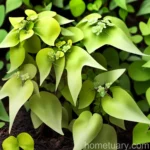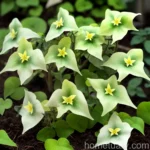Bishop’s hat (Epimedium pinnatum subsp. colchicum): A Comprehensive Guide
In the world of horticulture, the bishop’s hat plant, scientifically known as Epimedium pinnatum subsp. colchicum, is a fascinating and versatile perennial that has gained popularity among gardening enthusiasts for its delicate beauty and ease of care. This comprehensive guide will delve into the culture, uses, care, and maintenance of this exquisite plant, providing valuable insights for both novice and experienced gardeners.
What is the Bishop’s Hat Plant (Epimedium pinnatum subsp. colchicum)?
The bishop’s hat plant, Epimedium pinnatum subsp. colchicum, is a member of the Barberry family (Berberidaceae) and hails from the Caucasus and northern Iran. It is known for its graceful, heart-shaped leaves and dainty, spurred flowers that bloom in spring. This plant is valued not only for its ornamental appeal but also for its adaptability to various growing conditions, making it a sought-after choice for landscaping projects and home gardens.
Key Takeaways – Bishop’s Hat (Epimedium pinnatum subsp. colchicum)
To gain a comprehensive understanding of the bishop’s hat plant, it’s essential to explore its cultural significance, uses, and the key factors impacting its growth and health. This guide provides a detailed overview of each aspect, ensuring that readers are well-equipped to nurture and appreciate the beauty of this remarkable plant.
Culture
- Origin: Caucasus and northern Iran
- Family: Berberidaceae
- Type: Perennial
Uses
- Ornamental: Popular for landscaping and home gardens
- Groundcover: Effective as a groundcover due to its spreading nature
- Medicinal: Some species of Epimedium are used in traditional Chinese medicine
Now, let’s delve deeper into the specific care requirements for the bishop’s hat plant, ranging from water and sunlight needs to soil preferences and propagation methods.
Water
The bishop’s hat plant thrives in moist, well-drained soil. However, it’s crucial to avoid overwatering, as excessive moisture can lead to root rot and other issues. During the growing season, regular watering is recommended, ensuring that the soil remains consistently moist but not waterlogged. In contrast, reduced watering is advised during the plant’s dormant phase.
Sunlight
When it comes to sunlight, the bishop’s hat plant demonstrates a preference for partial to full shade. While it can tolerate some morning sun, especially in cooler climates, excessive exposure to direct sunlight can scorch its delicate foliage. Therefore, positioning the plant in a shaded or partially shaded area is ideal for promoting healthy growth and vibrant foliage.
Fertilizer
To support the bishop’s hat plant’s growth and flowering, applying a balanced, organic fertilizer in early spring is beneficial. This helps provide the necessary nutrients for robust growth and prolific blooming. Additionally, a layer of organic mulch can be applied around the base of the plant to retain moisture and suppress weed growth.
Soil
The bishop’s hat plant thrives in humus-rich, well-draining soil with a slightly acidic to neutral pH. A fertile, loamy soil with good moisture retention capabilities is conducive to healthy growth. Furthermore, incorporating organic matter into the soil, such as compost or well-rotted manure, can enhance its overall quality and fertility.
Pruning
Pruning the bishop’s hat plant is essential to maintain its tidy appearance and promote vigorous growth. In late winter or early spring, before the new growth emerges, any damaged or dead foliage can be removed. Additionally, cutting back the old stems to ground level helps rejuvenate the plant and encourages the development of fresh, vibrant foliage.
Propagation
The bishop’s hat plant can be propagated through various methods, including division, seed sowing, and rhizome cuttings. Division, which involves separating the plant into smaller sections with viable roots, is a common and reliable technique. This can be carried out in spring or fall, allowing the newly divided sections to establish themselves in favorable growing conditions.
Container Popularity
Due to its compact growth habit and ornamental appeal, the bishop’s hat plant is well-suited for container gardening. Its low-maintenance nature and adaptability make it an excellent choice for adding charm to balconies, patios, and other outdoor spaces. When cultivating this plant in containers, selecting a well-draining potting mix and providing adequate watering and lighting are crucial for its overall well-being.
Common Diseases
While the bishop’s hat plant is relatively resilient, it can be susceptible to certain diseases and issues that may impact its vitality. Being aware of these common ailments and employing preventive measures can safeguard the plant’s health and appearance.
- Powdery Mildew: This fungal disease can manifest as a powdery, white coating on the foliage, potentially hindering photosynthesis and weakening the plant. To prevent powdery mildew, fostering good air circulation and avoiding overhead watering are essential practices.
- Crown Rot: Excessive soil moisture and poor drainage can contribute to crown rot, causing the plant’s crown to rot and potentially leading to the plant’s demise. Implementing proper watering practices and ensuring well-draining soil can mitigate the risk of crown rot.
Disease Diagnosis
Early detection of diseases is paramount for effective management and control. Regularly inspecting the bishop’s hat plant for any signs of discoloration, wilting, or unusual growth can aid in identifying potential issues. Moreover, seeking the advice of a horticulturist or plant specialist can provide valuable insights into disease diagnosis and treatment options.
Common Pests
Pests, albeit less common, can pose a threat to the bishop’s hat plant. Vigilance and prompt intervention are crucial in addressing pest infestations and preserving the plant’s health.
- Aphids: These small, sap-sucking insects can congregate on the plant’s tender shoots and foliage, potentially causing distortion and stunted growth. Applying insecticidal soap or horticultural oil can help eradicate aphids while minimizing harm to beneficial insects.
- Spider Mites: These arachnids can inflict damage by piercing the plant’s cells and extracting sap, leading to stippling and the formation of fine webbing. Regularly spraying the plant with water and applying miticidal treatments can help manage spider mite populations.
Botanist’s Tips
For optimal growth and vitality of the bishop’s hat plant, incorporating the following tips can prove beneficial:
- Mulching: Applying a layer of organic mulch around the plant helps retain moisture, regulate soil temperature, and deter weed growth.
- Regular Inspection: Periodically inspecting the plant for signs of pests, diseases, or nutrient deficiencies enables timely intervention and ensures the plant’s well-being.
- Proper Air Circulation: Promoting good air circulation around the plant by spacing it adequately and avoiding overcrowding encourages healthy growth and minimizes disease susceptibility.
Fun Facts
- The bishop’s hat plant is renowned for its resilience, with certain species being adapted to thrive under challenging growing conditions, such as dry shade.
- Some varieties of Epimedium are referred to as “barrenwort,” alluding to their supposed aphrodisiac properties and historical use as a medicinal herb.
Now that we have explored the various facets of the bishop’s hat plant, including its cultural significance, care requirements, and potential challenges, let’s uncover some additional resources to broaden our knowledge and understanding of this remarkable species.
Links to External Resources
- The American Horticultural Society’s Encyclopedia of Plants and Flowers
- Royal Horticultural Society: Plant Finder
In conclusion, the bishop’s hat plant, Epimedium pinnatum subsp. colchicum, stands as a testament to nature’s elegance and adaptability. Through a harmonious blend of cultural significance, ornamental beauty, and diverse uses, this perennial has established itself as a beloved addition to gardens and landscapes worldwide. By embracing the insights and recommendations outlined in this guide, gardeners can cultivate and appreciate the enduring charm of the bishop’s hat plant, fostering a deeper connection with the wondrous realm of plant life.















